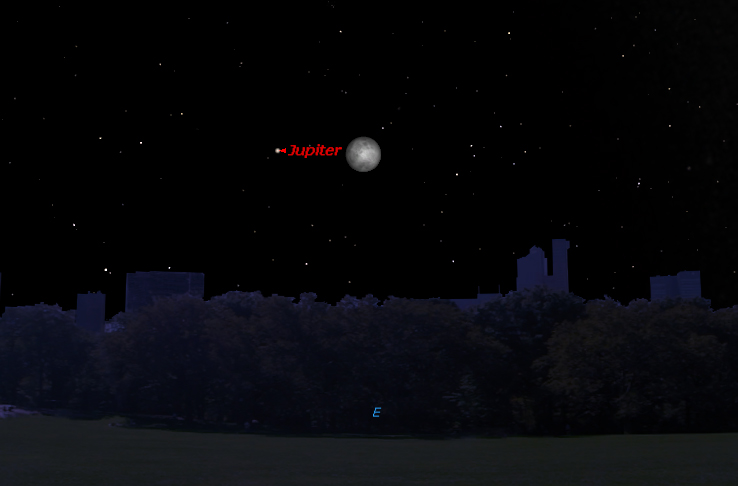
Look to the eastern sky tonight (Feb. 3) after dark to see an amazing sight.
If your sky is clear early this evening, about an hour after sundown, you might be able to see the February full moon — sometimes known as the "Snow Moon" — shining with the giant planet Jupiter in the east-northeast sky. Jupiter should be located to the left of the moon.
Both the moon and planet will keep each other company as they move across the night sky through the course of the night.
Jupiter will reach opposition on Feb. 6, meaning that it will be opposite to the sun in Earth's sky that day. Therefore, Jupiter rises around the time the sun sets, shines highest at around midnight and setting around sunrise. Opposition is also when Jupiter is closest to the Earth for the year, appearing biggest and brightest. Look for it in the east as the blue sky darkens. When you face Jupiter, Venus is almost directly behind you.
For amateur astronomers, Jupiter is a superb telescopic object. Its disk shows more illuminated surface area than all the other planets combined. Users of the very smallest telescopes or even steadily held binoculars can identify some or all of four of Jupiter's bright moons at any given time.
But the planet's disk itself also draws a lot of attention. In large telescopes interested observers can view its cloud belts. Sometimes, one or more of the belts can look strongly disturbed, full of knots and sprouting festoons. On the other side of the coin, however, the cloud belts might look more like pale belts crossing the planet. As always, seeing details on Jupiter requires a good quality telescope, good atmospheric seeing and patience behind the eyepiece.
Lastly, if clouds hide your view of the moon and Jupiter, don't fret. The two cosmic objects will shine together again in about one month, on March 2.
Get the Space.com Newsletter
Breaking space news, the latest updates on rocket launches, skywatching events and more!
Editor's note: If you snap an amazing skywatching photo of Jupiter and the moon or any other night sky view, and you'd like to share it for a possible story or image gallery, please contact managing editor Tariq Malik at spacephotos@space.com.
Joe Rao serves as an instructor and guest lecturer at New York's Hayden Planetarium. He writes about astronomy for Natural History magazine, the Farmer's Almanac and other publications, and he is also an on-camera meteorologist for News 12 Westchester, N.Y. Follow us @Spacedotcom, Facebook and Google+. Original article on Space.com.
Join our Space Forums to keep talking space on the latest missions, night sky and more! And if you have a news tip, correction or comment, let us know at: community@space.com.

Joe Rao is Space.com's skywatching columnist, as well as a veteran meteorologist and eclipse chaser who also serves as an instructor and guest lecturer at New York's Hayden Planetarium. He writes about astronomy for Natural History magazine, Sky & Telescope and other publications. Joe is an 8-time Emmy-nominated meteorologist who served the Putnam Valley region of New York for over 21 years. You can find him on Twitter and YouTube tracking lunar and solar eclipses, meteor showers and more. To find out Joe's latest project, visit him on Twitter.









